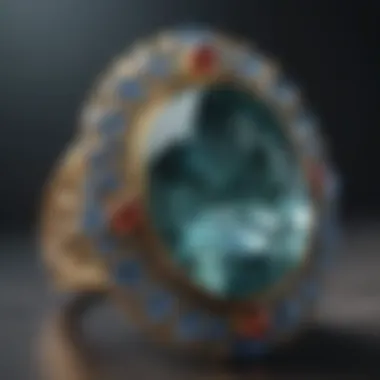Understanding Herderite Crystal: A Comprehensive Guide


Intro
Herderite crystals are not typically featured in mainstream gemstone discussions. Yet, their unique properties and intriguing origins capture the interest of collectors and enthusiasts alike. Understanding herderite involves exploring its geological formation, physical attributes, and its place in history and metaphysics. This exploration aims to untangle the complexities surrounding this underrated gemstone and appreciate its multifaceted nature.
Gemstone Overview
Definition of Gemstones
Gemstones are naturally occurring minerals or rocks that are prized for their beauty, rarity, and durability. Each variety offers unique characteristics, often making them valuable commodities for jewelry and other decorative uses. Herderite, in particular, is notable not just for its visual appeal, but also for its intricate crystal structure and fascinating geological story.
Classification of Gemstones
Gemstones can be broadly categorized into precious and semi-precious stones. Herderite is classified as a semi-precious gemstone, primarily due to its relative rarity. Within the realm of semi-precious stones, gemstones are further classified based on their composition, color, and other physical characteristics. Herderite crystals come in various forms, exhibiting hues of yellow, green, and pink, and they often have a glassy luster.
- Natural: Formed through geological processes without human intervention.
- Synthetic: Man-made gemstones that mimic natural stones but lack their authenticity.
- Organic: Derived from biological processes, such as pearls or amber.
Herderite, being a natural gemstone, captivates those interested in geology and metaphysical properties due to its formation process which occurs in granitic rocks.
Historical Significance
Origins of Gemstone Use
The use of gemstones dates back thousands of years. Ancient civilizations valued gems for various reasons: aesthetic adornment, trade, and spiritual significance. Herderite, while not as commonly referenced as more popular stones, has documented historical significance. It was often associated with specific rituals and healing practices among various cultures.
Cultural Insights: Gemstones in Ancient Civilizations
Gemstones served distinct roles in ancient societies, often symbolizing power or status. In cultures around the globe, gemstones were believed to possess protective and curative properties. For instance, herderite has been thought to possess unique metaphysical attributes related to mental clarity and emotional stability. Although specific historical records detailing the use of herderite are scarce, its geological rarity suggests it was valued even in ancient times.
"Gemstones have acted as a bridge between the tangible and the spiritual, embodying the mysteries of both nature and human belief systems."
Through understanding history and usage, we gain insight into the importance of herderite not just as a physical object, but as a reflection of human culture and belief systems.
The following sections will delve deeper into the physical properties, sourcing, and care of herderite crystals, offering practical knowledge for enthusiasts and collectors.
Foreword to Herderite Crystal
The introduction to Herderite crystal serves as a gateway for readers to appreciate the true value and intricacies of this unique gemstone. By exploring its definition and historical context, readers can better understand its significance within the realm of gemstones.
Knowing about Herderite opens up possibilities for collectors, enthusiasts, and jewelers. Its beauty is not just in appearance; the depth of its history and metaphysical attributes enriches its appeal. Readers will find that understanding Herderite involves more than just surface knowledge. It encompasses geological insights and value in spiritual practices.
Definition and Overview
Herderite is a lesser-known yet captivating borate mineral, primarily composed of calcium, barium, aluminum, and various other minerals. It is typically found in colors ranging from pale yellow to light green and sometimes even pink. The crystal structure of Herderite is orthorhombic and it is known for its distinctive prismatic shape.
This unique mineral often draws the interest of collectors for its rarity and striking appearance. It occurs in pegmatitic formations, where larger crystals exhibit distinct surfaces and light refraction. Its charm lies in both its aesthetic qualities and the profound meanings attributed to it.
Understanding the basic definition provides a pathway to explore various aspects of Herderite further.
Historical Background
The history of Herderite crystal is rich and intertwined with the history of gemstone discoveries. First described in the late 19th century by German mineralogist H. R. Herder, its name is derived from his work and contributions to mineralogy. Initially found in Brazil, it has since been discovered in several other locations, including Pakistan and Afghanistan.


Throughout the years, Herderite has drawn the attention of mineral collectors and gemologists alike due to its rarity. However, unlike more popular gemstones, it has not achieved widespread commercial use or recognition in the jewelry market.
The limited availability of Herderite has contributed to its allure, making it a topic of interest among those who seek unique and rare samples. Understanding its historical significance allows readers to appreciate not only the mineral itself but also its journey through time, tracing back its discovery and recognition.
Geological Formation of Herderite
The geological formation of herderite is integral to understanding this unique crystal. This section explores the mineral composition and the processes that lead to the creation of herderite. Knowledge of these aspects is vital, as it enhances appreciation for the crystal’s aesthetic and metaphysical value.
Mineral Composition
Herderite primarily consists of beryllium, aluminum, phosphorus, and oxygen. Its chemical formula is typically written as BeAl(PO₄)(OH). This composition is significant for several reasons.
- Beryllium Content: The presence of beryllium contributes to herderite’s remarkable transparency and brilliance.
- Aluminum and Phosphate: These elements also play a crucial role in the crystal’s formation, affecting its hardness and overall stability.
- Rare Content: Beryllium is relatively rare in the earth’s crust, and its connection to herderite makes this crystal distinctive among other minerals.
The unique mineral composition of herderite defines its physical properties and determines its applications, particularly in jewelry.
Formation Process
Herderite forms through a complex geological process often occurring in granitic pegmatites. This formation process can be described in various stages:
- Geological Setting: Herderite typically develops in environments where beryllium-bearing minerals are present. These pegmatitic deposits form under high temperature and pressure.
- Crystallization: As magma cools, the conditions allow for the crystallization of herderite, fostering the growth of well-defined crystals with distinctive shapes.
- Alteration: Post-crystallization, herderite can be subject to alteration through hydrothermal processes, which enhance its clarity and luster.
Understanding how herderite is formed offers valuable insights into its rarity and desirability. The geological processes not only contribute to the crystal’s beauty but also to its place in both collectors’ displays and jewelry designs.
"The rarity of herderite is a reflection of its complex formation, making it all the more intriguing for enthusiasts and collectors."
By comprehending the mineral composition and formation process, one can appreciate the value and significance of herderite in various contexts.
Physical Properties of Herderite Crystal
The exploration of the physical properties of herderite crystal plays a vital role in understanding both the gemstone's allure and its practical applications. Knowledge of these properties allows enthusiasts, collectors, and designers to appreciate the crystal's uniqueness. Properties such as crystal structure, color variability, and hardness contribute significantly to its appeal and usability in various domains. Each distinct characteristic imparts its own significance, reflecting the crystal's unique beauty and forming the basis for its metaphysical attributes.
Crystal Structure
Herderite crystal crystallizes in the orthorhombic system, which implies unique symmetry in its crystal form. The typical crystal habit is prismatic, often forming elongated or tabular shapes. These geometric forms are fundamental not only to its aesthetic appeal but also to how light refracts through it. These optical properties enhance the stone's brilliance and glow. Most commonly, herderite is seen in well-formed, transparent to translucent crystals, adding to its desirability among gemstone collectors.
It is also important to note the internal arrangement of atoms in herderite. The complex structure typically contains a combination of beryllium, aluminum, and phosphate ions, which contribute to its distinctive qualities. Understanding this aspect helps to highlight why herderite may exhibit specific responses in varied environments, especially in regards to wear and the influences of surrounding materials.
Color Variability
Herderite offers a fascinating color variation that ranges predominantly from colorless to pale yellow and pink shades. In certain instances, one may also encounter deeper hues, such as brown or green. This variability can be attributed to trace elements and the mineral’s formation conditions. Color greatly influences the market value of gemstones. Typically, lighter shades are favored over darker ones, creating a delicate balance between rarity and desire.
The beauty of herderite can make it a focal point in jewelry designs. Its color changes under different lighting conditions, which can surprise onlookers and collectors alike. This property makes it an intriguing gem for those in the jewelry industry, as colors shift and play depending on how light strikes the surface.
Hardness and Durability
In terms of hardness, herderite ranks between 5 and 5.5 on the Mohs scale. This scale is crucial for determining a gemstone's durability. While many well-known stones are harder, herderite still offers a reasonable level of durability for jewelry use with proper care. It's essential to consider that although herderite is workable, caution is advised during everyday wear as it can be susceptible to scratching or chipping if subjected to harsh conditions.
Taking care of herderite pieces involves mindful practices. Because of its moderate hardness, it may be best suited for pendants, earrings, or items that do not face constant abrasion. Proper handling and care enhance its longevity, making the study of appropriate usage critical for enthusiasts and designers who seek to incorporate this stone into their collections.
"Understanding the physical properties of herderite provides the foundation for its practical applications and aesthetic appreciation."


In summary, the physical properties of herderite crystal are foundational in understanding its appeal, viability in jewelry design, and its broader implications for both wearers and collectors. With distinct crystalline forms, captivating colors, and the balance of hardness, herderite stands out among gemstones, drawing both interest and admiration.
Metaphysical Properties
The metaphysical properties of herderite crystal are significant aspects that appeal to many enthusiasts and collectors. These attributes are often linked to the spiritual and emotional realms, transcending beyond mere geological and physical characteristics. For those who believe in the healing powers of crystals, understanding these metaphysical qualities can deepen the appreciation of herderite.
Healing Attributes
Herderite is thought by many to possess various healing attributes. It is commonly believed to promote relaxation and reduce stress, making it an ideal companion for those seeking tranquility in their lives. Individuals often use herderite during meditation to enhance clarity and focus. The stone is said to support emotional healing, particularly helping individuals let go of past traumas. This ability to facilitate emotional processing is vital for those on a journey of self-discovery and personal growth.
Furthermore, herderite may assist in enhancing communication skills, fostering better understanding between individuals. This can lead to improved relationships and a more harmonious environment. Users claim that holding or wearing herderite during challenging discussions can bring calming energy, facilitating a more open exchange of ideas.
"Herderite's calming energies create a space where healing can truly begin."
Spiritual Significance
The spiritual significance of herderite extends into realms of higher consciousness and enlightenment. Many believe that this crystal is a powerful tool for spiritual development. It is often associated with the third eye chakra, which governs intuition and perception. Individuals who work with herderite may find their intuitive abilities sharpened, allowing for better discernment in various aspects of life.
Additionally, herderite is said to strengthen connections to spiritual realms, providing guidance and insight from higher entities. Its vibration is believed to uplift the spirit, promoting a deeper sense of purpose and connection with the universe. Many people incorporate herderite into their spiritual practices, such as crystal grids or ceremonies, enhancing the depth of their experience.
In summary, the metaphysical properties of herderite encompass a broad range of healing and spiritual attributes. These aspects not only enrich the understanding of the crystal but also elevate its value in the world of gemstones. This multifaceted nature offers myriad benefits to those open to exploring the profound dimensions of herderite.
Sourcing Herderite
Sourcing herderite is crucial for understanding its broader implications in the gemstones market. Not only does it allow enthusiasts and collectors to appreciate the origins of this unique crystal, but it also facilitates informed purchasing decisions. Knowledge about where herderite comes from can enhance the enjoyment of the stone, adding layers of significance and value.
Major Localities
Herderite is primarily found in a few notable localities. The most prominent sites include Brazil and Pakistan. Each location produces stones that vary slightly in color and transparency, contributing to the overall diversity found in the market. Brazil is known for its vibrant yellow and green hues, while Pakistani herderite often displays more muted tones, which can be appealing to some buyers.
- Brazil
- Pakistan
- Known for rich color variations.
- High quality with greater clarity.
- Offers unique tones.
- Often exhibits inclusions that tell a story.
Additionally, lesser-known deposits in Afghanistan and Madagascar have surfaced in recent years, providing opportunities for gems with distinctive characteristics. The inclusions and variations inherent in each locality further attain special value among collectors.
Ethical Considerations in Mining
The ethics surrounding the mining of herderite are significant. As with many gemstones, the extraction process raises concerns about environmental sustainability, labor rights, and local community impacts. Responsible sourcing practices are essential to ensure that mining operations do not exploit workers or harm ecosystems.
Many consumers are now scrutinizing the sources of their gemstones. They are drawn to suppliers that adhere to ethical mining standards, ensuring that their crystals are not only beautiful but also responsibly obtained. Buyers should consider asking questions such as:
- Where is the herderite sourced from?
- What mining practices are used?
- Are workers treated fairly?
Engaging with sellers who are transparent about their sourcing can help support ethical practices in the industry. In summary, the importance of sourcing herderite lies beyond the stone itself; it encompasses an ethical responsibility that every enthusiast should consider.
Caring for Herderite Jewelry
Caring for herderite jewelry is crucial to maintain its aesthetic appeal and ensure its longevity. Being a relatively softer gemstone, herderite requires careful handling. Its unique properties call for specific cleaning and storage practices that help to protect its beauty and structural integrity. For gemstone enthusiasts, collectors, and jewelry designers, proper care is essential to retain the gemstone's natural splendor and metaphysical attributes. This section will explore effective cleaning techniques and provide valuable storage recommendations.


Cleaning Techniques
When it comes to cleaning herderite jewelry, gentle methods are the best approach. Here are some recommended techniques:
- Use Mild Soapy Water: Prepare a solution with mild dish soap and lukewarm water. Gently scrub your herderite pieces using a soft cloth or a soft-bristled toothbrush. This method effectively removes dirt and oils without scratching the surface.
- Avoid Harsh Chemicals: Steer clear of any cleaning products that contain bleach or ammonia. Such harsh substances can damage the surface and alter the color of herderite, diminishing its appeal.
- Rinse Thoroughly: After cleaning, rinse the jewelry in clean water to eliminate any soap residue. Ensure that it is entirely dry before storing or wearing it again.
- Professional Cleaning: For intricate designs or significant dirt buildup, consider seeking professional cleaning services. Experts can ensure that the gemstone is treated with care, further preserving its appearance.
Storage Recommendations
Proper storage of herderite jewelry helps prevent scratches and damage when not in use. Here are some effective suggestions:
- Separate Storage: Store herderite pieces separately to avoid contact with other harder gemstones, such as diamonds, that could scratch the surface. Use soft pouches or individual compartments in jewelry boxes.
- Avoid Direct Sunlight: Herderite can fade if exposed to prolonged sunlight. Keep it in a dark, cool place, away from direct sunlight and extreme temperatures.
- Humidity Control: Maintain a moderate humidity level in the storage area. Excess moisture can lead to the development of unwanted mold or damage to the jewelry's setting.
- Periodic Checks: Regularly inspect your stored herderite pieces. Ensure no deterioration or changing conditions are affecting their condition.
By adopting these cleaning techniques and storage recommendations, herderite jewelry can retain its captivating beauty over time. Understanding how to care for these pieces reflects a deeper appreciation for the gemstone itself. It also reinforces its role in both personal adornment and historical significance.
Herderite in Jewelry Design
The inclusion of herderite in jewelry design opens a unique avenue for gemstone enthusiasts and collectors. This crystal carries not only aesthetic appeal but also deep meaning that resonates with many. Jewelry designers find herderite particularly appealing due to its distinct properties and characteristics. The interesting aspects of herderite provide both visual and emotional elements that enhance any piece of jewelry.
Trends in Jewelry Making
Recent trends in jewelry making show a growing affinity for unique and less conventional gemstones. Herderite is increasingly being valued as designers and consumers alike search for originality. Its clarity and reflective properties allow for intricate and sophisticated designs.
- Naturalism: Many jewelry pieces using herderite favor a more organic and earthy approach. This trend aligns with a broader movement toward sustainable and natural materials in fashion.
- Mixed Materials: Designers are experimenting with herderite alongside metal types like gold or silver, creating contrasts that draw the eye. The natural hues of herderite blend well with various metals, enhancing the overall appearance of the jewelry.
- Minimalism: Simple designs featuring herderite are also gaining popularity. The stone's natural beauty often shines without overly elaborate settings.
Design Inspirations
Inspirations for herderite jewelry design often draw from its unique characteristics. Designers are encouraged to explore the various colors and textures that this crystal offers. Whether aiming for luxury or everyday wear, the adaptability of herderite is notable.
- Color Palettes: The variety of colors in herderite can influence a collection's theme. Shades range from clear to subtle greens and yellows, lending themselves well to seasonal trends.
- Symbolism: Many artists incorporate the metaphysical properties of herderite into their designs. Its healing and spiritual significance can appeal to those looking for pieces that offer meaning beyond aesthetics.
- Cultural Influence: The rich history of herderite and its associations can inspire designs that reflect cultural narratives or stories, providing depth to the jewelry pieces.
"Herderite's captivating aesthetic combined with its metaphysical significance create a perfect fusion in contemporary jewelry design, providing a voice to the stone and the wearer."
Incorporating herderite into jewelry design not only enhances personal style but also expresses individuality and meaning. This makes herderite a valuable asset for jewelry creators and a sought-after choice for buyers.
Common Misconceptions about Herderite
Understanding the common misconceptions surrounding herderite is essential for gemstone enthusiasts and collectors. Misconceptions can often lead to confusion or mistakes in purchasing and caring for these crystals. By addressing these myths, we can better appreciate this unique gemstone.
Myths and Facts
Herderite is often shrouded in myths that may not be based on scientific evidence. Here, we will explore several prevalent myths about herderite and clarify the facts that debunk these misunderstandings.
- Myth 1: Herderite is only found in one location.
Fact: Herderite has been discovered in various geological locations around the world, including Brazil and Madagascar. While certain localities might produce higher quality specimens, suggesting that it is exclusive to a single site is misleading. - Myth 2: All herderite crystals are green in color.
Fact: While green is a common hue for herderite, it is not the only color available. Herderite can also be found in shades of pink, yellow, and colorless variations. This diversity in color adds to the gemstone's appeal. - Myth 3: Herderite is a synthetic or lab-created stone.
Fact: Herderite is a natural mineral with unique properties. Although synthetic gemstones exist in the market, herderite’s formation process is entirely natural and cannot be replicated in laboratories. - Myth 4: The metaphysical properties of herderite are purely anecdotal.
Fact: While the metaphysical properties are not scientifically proven, many enthusiasts report positive experiences associated with herderite. These experiences can provide significant insights and personal value to those who believe in crystals' energy. - Myth 5: Herderite is too fragile for everyday jewelry.
Fact: Herderite has a hardness of 5 to 5.5 on the Mohs scale, which makes it reasonably durable for jewelry. Care should be taken to avoid harsh conditions, but it can still be enjoyed in various settings.
Understanding these common myths and the corresponding facts helps to foster a more informed perspective among collectors and enthusiasts. Knowing the reality surrounding herderite can enhance appreciation and enhance decision-making when it comes to buying or using this gemstone.
By debunking these myths, we pave the way for a more sensible engagement with herderite. This exploration reveals the uniqueness of herderite, encouraging proper care and consideration when integrating it into personal collections or jewelry designs.
Culmination
The exploration of herderite crystal captures a nuanced spectrum of significance that goes beyond mere aesthetic appeal. Recognizing its geological, physical, and metaphysical properties can greatly enhance appreciation among enthusiasts. By delving into the specifics surrounding herderite, collectors and jewelry designers can harness its unique characteristics in ways that elevate their work or collections.
The Value of Understanding Herderite
Understanding herderite entails recognizing its value on multiple fronts:
- Geological Insight: Herderite's formation reveals intricacies in mineral composition and geological processes.
- Aesthetic Versatility: Its stunning colors and crystalline structure make it a desirable choice for jewelry designs.
- Metaphysical Attributes: Knowledge of herderite’s purported healing and spiritual properties can enrich one’s personal practices or give deeper meaning to its use in jewelry.
In essence, a comprehensive understanding equips individuals to make informed decisions about sourcing, crafting, and utilizing this exceptional gemstone. By dispelling myths surrounding herderite, the community can foster a fundamental appreciation for its intrinsic value and significance.



